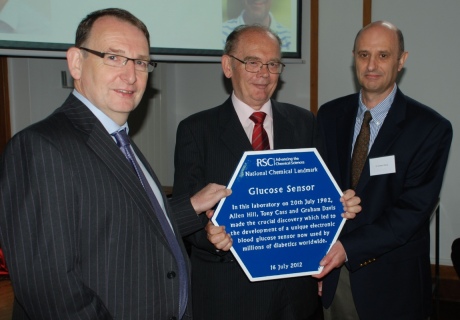Blue plaque for team behind diabetic breakthrough
by Simon Levey

Royal Society of Chemistry Landmark Blue Plaque
Imperial scientist who made a difference to millions of diabetes sufferers is celebrated with a permanent commemorative plaque at Oxford laboratory
The work of three scientists who together made a difference to the lives of millions of diabetes sufferers was celebrated this week with the unveiling of a permanent commemorative plaque.
Using a new chemical technique the scientific trio created a medical device for people with diabetes that allows them to easily monitor the level of sugar in their blood using just a pin-prick in the finger and a tiny drop.
Tony Cass, who is now Professor of Chemistry at Imperial College London, and former colleagues Allen Hill and Graham Davis have been immortalised in a National Chemical Landmark blue plaque presented by the Royal Society of Chemistry. The plaque was erected at the Oxford laboratory where they carried out the work in the 1980's.
Previously glucose monitoring had been carried out using 'colorimetric' methods, where a drop of blood was applied to a strip that changed colour to indicate the concentration of glucose in the blood. But these methods required a large droplet of blood and were not very accurate.
The new approach developed a new technique that enabled a range of proteins to be investigated electrochemically, paving the way for a new type of monitoring device. It started with work into how proteins gain or lose electrons when linked in to an electrical circuit. Studying such electrochemical behaviour was difficult as the proteins tended to stick to the electrodes, creating a build-up that prevented a current from flowing.
Professor Allen developed a way of protecting the electrodes by binding another molecule to them that did not interfere with the current. The protein could now pick up an electron from one electrode via the surface bound molecule and lose it at the other electrode: allowing a huge range of proteins to be investigated electrochemically for the first time.

Professors Tony Cass and Oxford colleagues Allen Hill and Graham Davis (L-R)
In 1982 Allen, working with Tony Cass and Graham Davis, overcame a major drawback of the new method when applied to enzymes that used oxygen – the latter interfered with the electron transfer processes. They used ferrocene as a carrier of the electrons thereby creating a much more stable system. By using the enzyme which breaks down glucose (glucose oxidase) as the protein component in the device they were able to construct a new type of sensor.
Glucose oxidase reacts with any glucose in a sample, giving up electrons that are passed on to the electrode via the oxidised ferrocene: the larger the concentration of glucose the larger the current measured by the device.
Importantly, the new device needed just the tiniest pinprick of blood, would work with blood straight from the body, and could measure glucose levels much more accurately than colorimetric methods. The new glucose monitoring device was commercialised and went on sale in 1989, it is now used by people with diabetes around the world.
Adapted from a news release by the Royal Society of Chemistry.
Article text (excluding photos or graphics) © Imperial College London.
Photos and graphics subject to third party copyright used with permission or © Imperial College London.
Reporter
Simon Levey
Communications Division